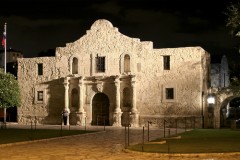LatinaLista — There’s probably no other battle on US soil that has been as romanticized as the Battle of the Alamo. On the flipside, there’s probably no other US battle that has been so heavily influenced by Hollywood-invented stereotypes, misrepresentations and outright exclusion of facts than the Battle of the Alamo.

Yet, on the day celebrating the 176th anniversary of the infamous battle, it looks like the caretakers of the Alamo legacy are ready to revise history in a way that accurately represents who was involved, who else were the heroes and what is the future of the most iconic symbol in American history.
Several news outlets report that over 500 people gathered this morning in San Antonio at the annual “Dawn at the Alamo” sponsored by the San Antonio Living History Association. Spectators watched as re-enactors of the battle took their positions to commemorate the two-hour final battle that saw the Alamo fall to General Santa Anna’s soldiers.
Back then, Texans were known as Texians and some of the more notable, those who history and Hollywood chose to remember, were Tennessee congressman and scout Davy Crockett, adventurer-entrepreneur James Bowie and a lawyer named William Barrett Travis, who was the Alamo’s commander.
What’s not often mentioned are the Tejanos who also contributed to the defense of the Alamo. Tejanos were Texans of Mexican heritage. The role Tejanos played at the Battle of the Alamo has largely been an untold story since many Tejanos were mistreated and distrusted by Anglo Texans after the battle and were wrongfully accused of helping General Santa Anna defeat the Alamo.
For background:
Very few of the 189 men who died at the Alamo were actually natives of Texas. A great number of them were from Southern states, such as Tennessee, Kentucky and the Carolinas. At least 32, in fact, came from Tennessee. Some northerners from Pennsylvania, Ohio and New York also stood their ground in the mission. But Europeans were also well represented. At least ten of the patriots were natives of England, and another 11 were from Ireland, a country that knew well the struggle for liberty against oppression. Of the thirty-plus Europeans, some also came from Germany, Denmark, Scotland and Wales.
At the time of the battle, as many as eighty of the Alamo defenders were actually documented residents of Texas, but others had traveled to the fort from various states, volunteering their services for the revolution. Of the estimated 189 men who died in the Alamo, only six were actually born in Texas: Juan Abamillo, Juan A. Badillo, Carlos Espalier, Gregorio Esparza, Antonio Fuentes, and Andrés Nava.
One man who played a very significant role in the fight for independence was Juan Nepomuceno Seguín (1806-1890). A native of San Antonio, Seguín is probably the most famous Tejano to be involved in the War of Texas Independence. His story is complex because he joined the Anglo rebels and helped defeat the Mexican forces of Santa Anna. But later on, as Mayor of San Antonio, he and other Tejanos felt the hostile encroachments of the growing Anglo power against them. After receiving a series of death threats, Seguín relocated his family in Mexico, where he was coerced into military service and fought against the US in 1846-1848 Mexican War.
Ever since the Alamo was converted into a memorial to the fallen defenders of that fateful day, one group has been largely in charge of maintaining it — The Daughters of the Republic of Texas (DRT). Their focus had been on maintaining the Alamo as a “sacred memorial to the heroes who immolated themselves.”
Too often though, the contributions of Tejanos were either ignored or dismissed by the DRT. Not anymore according to a new management agreement with the Texas Land Office, that has now taken over chief custodial duties from the DRT but leaves the DRT in charge of managing the 300-year-old buildings — if they comply with one rule: “the Daughters must offer programs that emphasize historical truth and address the Alamo’s ‘diverse and rich heritage.'”
That it has taken more than 100 years to get the proper recognition for Tejano defenders is not lost on present-day Tejanos. Current Tejanos got fed up long ago with the DRT and the state’s version of Alamo history and decided a few years ago to create a site, Texas Tejano, to educate people about the role of Tejanos, not only about the Alamo, but in the founding and growth of Texas.
The DRT has begun to change its ways in regard to Tejanos by finally dedicating a picture of one Tejana, Adina De Zavala, who also happened to be an early member of the DRT, and who was ousted from the group for challenging the others on how they wanted to preserve the Alamo and its legacy.
Going forward, it’s clear that the role of Tejanos at the Alamo will be known by more than just history buffs. In fact, the Alamo is part of the five San Antonio Franciscan missions that is nominated to be globally recognized as a World Heritage site.
If the missions should garner enough votes then the bravery, deeds and exploits of Tejanos will gain their proper due from more than just history books.


